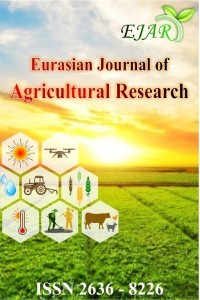Effect of Water Stress on Crop Coefficient of Irrigated Soybeans (Glycine max L merr.) under sub-humid Conditions
Effect of Water Stress on Crop Coefficient of Irrigated Soybeans (Glycine max L merr.) under sub-humid Conditions
Drip irrigation, soybeans, crop coefficient, full and deficit irrigation,
___
- Adeboye O.B., Schultz B., Adekalu K.O. & Prasad K., 2015. Crop water productivity and economic evaluation of drip-irrigated soybeans (Glyxine max L. Merr.). Agriculture & Food Security, 4(1), 1-13. 10.1186/s40066-015-0030-8.
- Ali M.H. 2010. Fundamentals of irrigation and on-farm water management. Springer, Berlin.
- Allen, R.G., Pereira, L.S., Raes, D. Smith, M., 1998. Crop Evapotranspiration-Guidelines for computing crop water requirements. Irrigation and Drainage Paper. Food and Agriculture Organization, Rome, Italy.
- de Medeiros G.A., Arruda F.B., Sakai E.l. & Fujiwara M. 2001. The influence of crop canopy on evapotranspiration and crop coefficient of beans (Phaseolus vulgaris L.). Agricultural Water Management, 49(3), 211-224. https://doi.org/10.1016/S0378-3774(00)00150-5.
- Decagon D.I. 2015. Using AccuPAR to Find Crop Coefficients for Irrigated Grapevine Production.
- Doorenbos J. Pruitt & W.O. 1977. Crop water requirements, Irrigation and Drainage No. 24. Food and Agriculture Organization, Rome, Italy.
- Gardner W.H. 1986. Water Content. In: A. Klute (Editor), Methods of Soil Analysis: Part 1-Physical and Mineralogical Methods. Soil Science Society of America Book Series. Soil Science Society of America, American Society of Agronomy, Madison, WI, pp. 493-544.
- Ghinassi G. 2008. Manual for performance evaluation of sprinkler and drip irrigation systems, ICID Publication No. 94. International Commission on Irrigation and Drainage, Delhi, India, 119 pp.
- Hanson B.R. May D.M. 2006. Crop coefficients for drip-irrigated processing tomato. Agricultural Water Management, 81(3), 381-399. https://doi.org/10.10 16/j.ag wat.20 05.04.007.
- Justice C.O. Townshend & J.R.G. 2002. Special issue on the Moderate Resolution Imaging Spectroradiometer (MODIS): A new generation of land surface monitoring. Remote Sensing Environment, 83, 1-12.
- Kamble B. Irmak A. 2008. Assimilating Remote Sensing-Based ET into SWAP Model for Improved Estimation of Hydrological Predictions., Proceeding of the 2008 IEEE International Geoscience and Remote Sensing Symposium, Boston, USA.
- Kang S., Gu B., Du T. & Zhang J. 2003. Crop coefficient and ratio of transpiration to evapotranspiration of winter wheat and maize in a semi-humid region. Agricultural Water Management, 59, 239–254.
- Kashyap P.S. & Panda R.K. 2001. Evaluation of evapotranspiration estimation methods and development of crop-coefficients for potato crop in a sub-humid region. Agricultural Water Management, 50, 9-25.
- Lovelli S., Perniola M., Ferrara A. & Di Tommaso T. 2007. Yield response factor to water (Ky) and water use efficiency of Carthamus tinctorius L. and Solanum melongena L. Agricultural Water Management, 92(1–2), 73-80. http://dx.doi.org/10. 1016/j.agwat.2 007.05.005.
- Marin F.R. Angelocci L.R. Nassif D.S.P., Costa L.G., Vianna M.S. & Carvalho K.S., 2016. Crop coefficient changes with reference evapotranspiration for highly canopy-atmosphere coupled crops. Agricultural Water Management, 163 139–145. doi.org/10.1016/j.agwat.2015.09.010.
- Marsal J., Johnson S., Casadesus J., Lopez G., Girona J. & Stöckle C. 2014. Fraction of canopy intercepted radiation relates differently with crop coefficient depending on the season and the fruit tree species. Agricultural and Forest Meteorology, 184(Supplement C), 1-11. doi.org/10.1016/j.agrformet.2013.08.008.
- McMaster G.S., & Wilhelm W.W. 1997. Growing degree-days: one equation, two interpretations. Agricultural and Forest Meteorology, 87(4), 291-300. http://dx.doi.o rg/10.1016/S0168-1923(97)00027-0.
- Medeiros G.A., Arruda F.B., Sakai E. & Fujiwars M. 2001. The influence of crop canopy on evapotranspiration and crop coefficient of beans (Phaseolus vulgaris L.). Agricultural Water Management, 49, 221-224.
- Michael A.M. 2008. Irrigation Theory and Practice, Vikas Publishing House PVT, New Delhi, 768 pp.
- Payero J.O. & Irmak S. 2013. Daily energy fluxes, evapotranspiration and crop coefficient of soybean. Agricultural Water Management, 129, 31– 43. http://dx.doi.org/10.1016/j.a gwat.2013.06.018.
- Pereira A.R., Camargo M.B.P.d. & Villa Nova, N.A., 2011. Coffee crop coefficient for precision irrigation based on leaf area index. Bragantia 70, 946-951.
- Pereira L.S. Perrier A. Allen F.G. & Alves I. 1999. Evapotranspiration: concepts and future trends. Journal of Irrigation and Drainage Engineering, 125, 45-51.
- Rai R.K. Singh V.P. & Upadhyay A. 2017. Way Forward to Improve Irrigation Efficiency, Planning and Evaluation of Irrigation Projects. Academic Press, pp. 605-611.
- Reinders F.B. & Niekerk A.S.V. 2018. Technology Smart Approach to Keep Drip Irrigation Systems Functional. Irrigation & Drainage, 67(1), 82-88. doi:10.1002/ird.2191.
- Richter B. 2014. Taking Stock of Our Water Budgets, Chasing Water: A Guide for Moving from Scarcity to Sustainability. Island Press/Center for Resource Economics, Washington, DC, pp. 19-35.
- Suyker A.E. & Verma S.B. 2009. Evapotranspiration of irrigated and rainfed maize–soybean cropping systems. Agricultural & Forest Meteorology, 149(3), 443-452. https://doi.org/10.1016/j.agrformet.2008.09.010.
- Williams L.E. & Ayars J.E. 2005. Grapevine water use and the crop coefficient are linear functions of the shaded area measured beneath the canopy. Agricultural & Forest Meteorology, 132(3-4), 201-211.
- Williams L.E., Phene C.J., Grimes D.W. & Trout T.J. 2003. Water use of young Thompson Seedless grapevines in California. Irrigation Science, 22, 1-9.
- Zhang X., Qin W., Chen S., Shao L. & Sun H. 2017. Responses of yield and WUE of winter wheat to water stress during the past three decades-A case study in the North China Plain. Agricultural Water Management, 179, 47-54. http://dx.doi.org/10.1016/j.ag wa t.2016.05.004.
- ISSN: 2636-8226
- Yayın Aralığı: Yılda 2 Sayı
- Başlangıç: 2017
- Yayıncı: Muhammed Cüneyt BAĞDATLI
Determination of Land Use Capabilities by GIS Analysis in Nigde Province, Turkey
M. Cüneyt BAĞDATLI, Mehmet Eren ÖZTEKİN
The Importance of Vermicompost in Agricultural Production and Economy
Ehlinaz TORUN KAYABAŞI, Orhan YILMAZ
A Review on the Integrated Rice-Based Cropping Systems Practices in the Philippines
Kathlyn L. QUION, Ulysses CAGASAN
Negative Effects of Global Climate Change on Agriculture Production
Analysis of The Impact of Agricultural Policies on Food Security in Kenya
Composition and Sensory Properties of Wheat, Plantain and Cocoyam Flour Doughnuts
John ADANSE, Antwi-boasiako SUSSANA, Kate BIGSON, Kwakudua Ruth SITSOFE
The Effects of Global Warming on Fish Farming Water Resources
